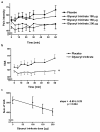Nitric oxide is negatively correlated to pain during acute inflammation
- PMID: 20843331
- PMCID: PMC2949722
- DOI: 10.1186/1744-8069-6-55
Nitric oxide is negatively correlated to pain during acute inflammation
Abstract
Background: The role that nitric oxide (NO) plays in modulating pain in the periphery is unclear. We show here, the results of two independent clinical studies (microdialysis and gene expression studies) and a pilot dose finding study (glyceryl trinitrate study), to study the role of NO in the early phase of acute inflammatory pain following oral surgery. The effect of ketorolac on NO production and nitric oxide synthase (NOS) gene expression was also studied.
Results: Microdialysis samples showed significantly higher levels of NO at the first 100 min compared to the last 80 minutes in the placebo treated group. In the ketorolac group, on the other hand, NO levels gradually decreased over the first 60 min but were similar to placebo over the later 100-180 min, with no significant change in NO level over time. The levels of NO were negatively correlated to pain intensity scores. Local infusion of the NO donor glyceryl trinitrate at the site of surgery, showed a small analgesic effect that did not reach statistical significance in the sample size used. While the gene expression of iNOS and eNOS were not up-regulated, 3 hours after surgery, nNOS was downregulated in both treatment groups and eNOS gene expression was significantly lower in the ketorolac group compared to the placebo group. Further, there was a positive correlation between the change in gene expression of nNOS and eNOS in the placebo group but not in the ketorolac group.
Conclusion: We suggest that at this early stage of inflammatory pain in man, NO is analgesic in the periphery. Further, ketorolac down-regulates eNOS gene expression.
Figures




References
-
- McMahon SB, Bennett DLH, Bevan S. In: Wall and Melzack's Textbook of Pain. McMahon SB, Koltzenburg M, editor. Edinburgh: Elsevier Churchill Livingstone; 2006. Inflammatory mediators and modulators of pain; pp. 49–72.
Publication types
MeSH terms
Substances
Grants and funding
LinkOut - more resources
Full Text Sources
Medical

